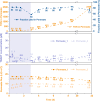Membrane-based TBADT recovery as a strategy to increase the sustainability of continuous-flow photocatalytic HAT transformations
- PMID: 36257941
- PMCID: PMC9579200
- DOI: 10.1038/s41467-022-33821-9
Membrane-based TBADT recovery as a strategy to increase the sustainability of continuous-flow photocatalytic HAT transformations
Abstract
Photocatalytic hydrogen atom transfer (HAT) processes have been the object of numerous studies showcasing the potential of the homogeneous photocatalyst tetrabutylammonium decatungstate (TBADT) for the functionalization of C(sp3)-H bonds. However, to translate these studies into large-scale industrial processes, careful considerations of catalyst loading, cost, and removal are required. This work presents organic solvent nanofiltration (OSN) as an answer to reduce TBADT consumption, increase its turnover number and lower its concentration in the product solution, thus enabling large-scale photocatalytic HAT-based transformations. The operating parameters for a suitable membrane for TBADT recovery in acetonitrile were optimized. Continuous photocatalytic C(sp3)-H alkylation and amination reactions were carried out with in-line TBADT recovery via two OSN steps. Promisingly, the observed product yields for the reactions with in-line catalyst recycling are comparable to those of reactions performed with pristine TBADT, therefore highlighting that not only catalyst recovery (>99%, TON > 8400) is a possibility, but also that it does not happen at the expense of reaction performance.
© 2022. The Author(s).
Conflict of interest statement
One of the co-authors (M.N.) is an employee of Vapourtec Ltd., i.e. the company that commercializes the reactor used in this study.
Figures






Similar articles
-
Optimization of a Decatungstate-Catalyzed C(sp3)-H Alkylation Using a Continuous Oscillatory Millistructured Photoreactor.Org Process Res Dev. 2020 Oct 16;24(10):2356-2361. doi: 10.1021/acs.oprd.0c00235. Epub 2020 Jul 9. Org Process Res Dev. 2020. PMID: 33100815 Free PMC article.
-
Asymmetric Photocatalytic C(sp3)-H Bond Addition to α-Substituted Acrylates.Org Lett. 2021 Apr 16;23(8):3157-3161. doi: 10.1021/acs.orglett.1c00801. Epub 2021 Mar 29. Org Lett. 2021. PMID: 33780255
-
C(sp3)-C(sp3) Coupling of Cycloalkanes and Alkyl Halides via Dual Photocatalytic Hydrogen Atom Transfer and Nickel Catalysis.Org Lett. 2024 Apr 19;26(15):2993-2998. doi: 10.1021/acs.orglett.4c00567. Epub 2024 Apr 9. Org Lett. 2024. PMID: 38592728
-
Tetrabutylammonium decatungstate (TBADT), a compelling and trailblazing catalyst for visible-light-induced organic photocatalysis.Org Biomol Chem. 2024 May 15;22(19):3799-3842. doi: 10.1039/d4ob00171k. Org Biomol Chem. 2024. PMID: 38651982 Review.
-
Metallaphotoredox catalysis for sp3 C-H functionalizations through hydrogen atom transfer (HAT).Chem Soc Rev. 2023 Jun 19;52(12):4099-4120. doi: 10.1039/d3cs00023k. Chem Soc Rev. 2023. PMID: 37278288 Review.
Cited by
-
PDI-Functionalized Glass Beads: Efficient, Metal-Free Heterogeneous Photocatalysts Suitable for Flow Photochemistry.Org Process Res Dev. 2024 Sep 6;28(9):3698-3706. doi: 10.1021/acs.oprd.4c00256. eCollection 2024 Sep 20. Org Process Res Dev. 2024. PMID: 39323896 Free PMC article.
-
Recovery of homogeneous photocatalysts by covalent organic framework membranes.Nat Commun. 2023 May 11;14(1):2726. doi: 10.1038/s41467-023-38424-6. Nat Commun. 2023. PMID: 37169759 Free PMC article.
-
Tech-Enhanced Synthesis: Exploring the Synergy between Organic Chemistry and Technology.J Am Chem Soc. 2025 Aug 13;147(32):28523-28545. doi: 10.1021/jacs.5c10303. Epub 2025 Aug 5. J Am Chem Soc. 2025. PMID: 40762023 Free PMC article. Review.
-
Design and application of a decatungstate-based ionic liquid photocatalyst for sustainable hydrogen atom transfer reactions.Green Chem. 2025 Jun 3;27(25):7660-7666. doi: 10.1039/d5gc02160j. eCollection 2025 Jun 23. Green Chem. 2025. PMID: 40485667 Free PMC article.
-
Scale-Up of Continuous Metallaphotoredox Catalyzed C-O Coupling to a 10 kg-Scale Using Small Footprint Photochemical Taylor Vortex Flow Reactors.Org Process Res Dev. 2024 Dec 4;29(1):34-47. doi: 10.1021/acs.oprd.4c00262. eCollection 2025 Jan 17. Org Process Res Dev. 2024. PMID: 39839539 Free PMC article.
References
-
- Bonciolini, S., Noël T., Capaldo L. Synthetic applications of photocatalyzed halogen-radical mediated hydrogen atom transfer for C−H bond functionalization. Eur. J. Org. Chem.10.1002/ejoc.202200417 (2022).
LinkOut - more resources
Full Text Sources

